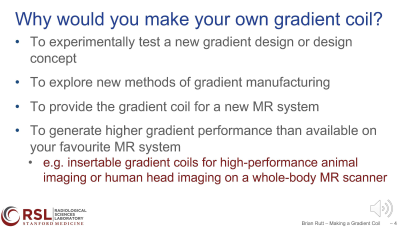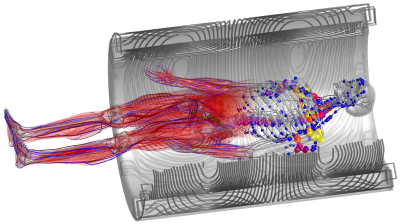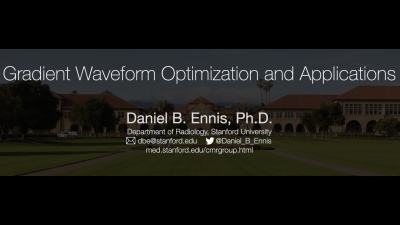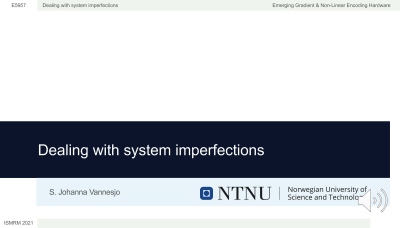Weekend Course
Pushing the Limit with Emerging Gradient & Non-Linear Encoding Hardware
ISMRM & SMRT Annual Meeting • 15-20 May 2021

| Concurrent 3 | 15:15 - 16:00 | Moderators: Maxim Zaitsev & David Feinberg |
 |
Making a Gradient Coil
Brian Rutt
This course outlines the various considerations involved in designing, building, assembling and testing a gradient coil prototype, from the perspective of an academic researcher. The following topics are reviewed during the course: 1) Why would you want to make your own gradient coil; 2) electromagnetic design considerations; 3) Preliminary construction considerations; 4) Mechanical design considerations; 5) Choice of materials; 6) Construction methods; 7) Testing and tuning. The lecture ends with a video showing the actual procedure of inserting a head gradient into a clinical whole-body 3T scanner and demonstrating the successful implementation of many of the concepts during the course.
|
|
 |
High-Performance Gradient Hardware
Matt Bernstein
This educational talk introduces basics of high-performance gradient hardware. Gradient slew rate and amplitude are defined, and related to gradient lobe duration. How gradient coil inductance and resistance, along with driver voltage and current, determine performance parameters is presented, as well as how inductance scales with coil radius. The efficiency of whole-body, insert, and compact (head-only) geometries is considered. Some effects of physiological and non-physiological limitations on gradient performance are discussed. Selected corrections methods are considered in the context of high-performance systems. Finally, a few representative examples of high-performance gradient hardware are discussed.
|
|
 |
The Role of PNS Simulation in Gradient Design
Mathias Davids
Peripheral Nervous Stimulation (PNS) has become the major limitation in many fast MRI sequences for state-of-the-art gradient systems. This educational talk provides an overview on how PNS modeling tools can inform the design phase of new gradient systems to maximize the safely usable image encoding performance.
|
|
 |
Gradient Waveform Optimization & Applications
Daniel Ennis
Gradient waveform design is necessary for all MRI pulse sequences. While closed form (analytic) solutions exist for many useful problems and are wide implemented, there are a number of interesting problems for which numerical optimization methods are needed. This talk briefly distinguishes between the analytic and computational approaches to gradient waveform design, then describes a number of applications for which computational approaches provide added value. Four-dimensional phase-contrast (4D-flow) MRI is one example for which time-optimal gradient waveform design can improve overall sequence efficiency by ~20% or more. Diffusion weighted MRI can be optimized for SNR-efficiency and to mitigate eddy currents.
|
|
 |
Non-Linear Encoding Fields & Integrated Shim Arrays
Gigi Galiana
There are several ways to understand the unique features of nonlinear spatial encoding, which has led to many different approaches and applications. These include interpretations invoking warped image space, projections onto curved isocontours, dynamically modulated kspace sampling, and modifiers to the point spread function. In addition to applications in accelerated imaging, these fields have found utility in improving slice excitation, as well as zoomed excitation and encoding. Most nonlinear encoding studies have been performed with relatively traditional gradient hardware, but the additional degrees of freedom offered by gradient and gradient/RF arrays offer many new possibilities.
|
|
 |
Dealing with System Imperfections
S. Johanna Vannesjo
Accurate spatial and temporal characteristics of the encoding magnetic fields are crucial for image quality. However, there will always be slight imperfections to the magnetic fields produced by gradient and shim systems. This educational lecture describes how to characterize the spatial and temporal magnetic field response of gradient and shim channels, and how to implement pre-emphasis based on an LTI model of the system.
|
The International Society for Magnetic Resonance in Medicine is accredited by the Accreditation Council for Continuing Medical Education to provide continuing medical education for physicians.